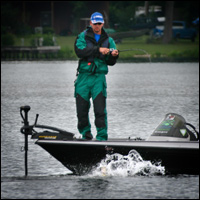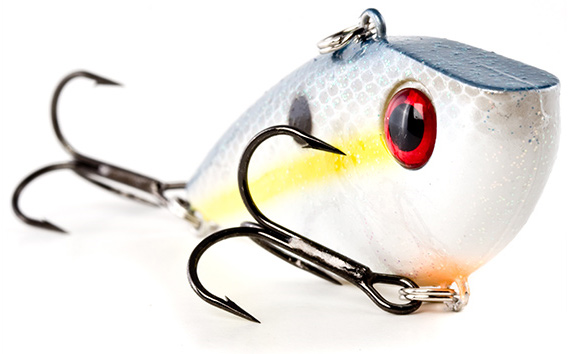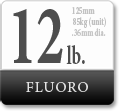
An Effective Winter Lure: The Lipless Crankbait
Published March 10, 2010 by Kevin ScarselliAt first thought, the lipless crankbait is far from typical when it comes to fishing in the winter months. When water temps get down into the 30’s, anglers tend to open up their “specialty” boxes filled with all kinds of winter-specific lures, such as hair jigs and blade baits. And when they can’t connect with these few cold weather lures, they assume that nothing else will.
It is my assertion that the lipless crankbait is a top 5 wintertime bait. Where it falls in that top 5 list is debatable, but today, I want to make a case for the lipless crankbait and explain why it works so well in the cold, and the techniques that will produce at this time of year with it.

A Lot To Contend With…
1. Bass Sitting On Bottom
In the winter, you got a lot of things to contend with. First and foremost, a lot of bass will be sitting on the bottom. While a few fish will suspend, if your fishing up off the bottom in the winter, you’re probably not catching fish.
2. Bass Are Relating To Structure
Second, the fish are more likely to be relating to structure instead of cover. In other words, it won’t be as easy as finding a laydown or stump and throwing at that cover. They are going to be on structure, such as ledges and drop offs. This kind of structure can only be seen with your sonar or good topo map.
3. Debris, and lot’s of it.
The third thing you’re contending with at this time of year is debris, be it on the surface or on the bottom. Most of the time it’s soggy leaves. It could also be really mucky algae-like slime that loves to cover any hard rocks or gravel. Try fishing a pond at this time of year with a lipped crankbait and see how many times you foul up… it’ll be every time.
4. Bass Are Grouped Up
Lastly, the fish will be grouped up much more than they are at other times of the year. This can be a good thing, but it does mean that areas of productive water are lessened. You will have to cover lots of water quickly to find those groups of fish. The only way to avoid having to cover lots of water is to know where the fish are already, but rarely is it that easy. Your sonar is your best friend, but unless you have a color graph or know how to read and spot fish with grayline, even that can be tough since these fish are often sitting right on the bottom.
Lipless Crankbait: Covering All The Bases
So with all these factors in mind, let’s discuss why the lipless crankbait is a top performer for these conditions.
Since bass will be sitting on the bottom, a lipless crankbait is perfect for fishing right on the bottom througout the whole retrieve. The beauty of the lipless crankbait is that there is no bill to dig into the bottom. During the winter, kicking up mud and debris with a diving bill is an overpowering presentation to low-metabolism fish. And with all the mucky leaves and slime on the bottom, a diving bill will foul up every cast.
Because a lipless crankbait is well, lipless, you can slowly swim it right on the bottom through the leaves and debris. That front treble hook will not foul up on leaves as much as you think, and only the leading hook point will snag algae. Though that leading hook point may snag slime, it won’t be enough to kill the action of the bait. And since you are fishing the bait along the bottom, the fish won’t notice you snagged the slime anyway. You just keep fishing the bait, knowing you have a little algae on that front tine.

So if you’re working your bait and you feel like you do snag a leaf, just give the rod a short and quick pump to shake it free or rip it off. I’d say about 75% of the time it will clear the hooks, which is perfectly acceptable. And for the best results, keep your rod tip high in the air as you are retrieving the lure, so as to keep the nose of the bait from digging into the bottom or debris. This is a critical aspect of being able to work a lipless crankbait through the bottom without fouling up constantly.
Fluorocarbon line is a must for this technique because of it’s low-stretch and feel. Bites will be light and you’ll need a low-stretch line to clear the hooks of debris. It’s invisibility is a major plus as well.
Covering Water In Winter
Since bass are going to be grouped up and the areas of productivity will be fewer, covering water will be crucial in finding those congregations of fish. Being a pro at reading your sonar is a major benefit, but let’s face it, not everyone is capable of interpreting their displays, nor does everyone have an expensive color sonar to work with. But all this doesn’t matter if you’re fishing a lipless crankbait. That lipless crankbait will be a much more efficient means of finding fish than your sonar. Use your sonar to find good structure, then put the lipless crankbait to work to find the fish.
Colors, Sizes and Equipment
For lipless crankbaits in the winter, there are really only two color patterns that you need to concern yourself with. A clear water color, and a stained water color. For clear water, any shad pattern will suffice. For dirty water, the name of the game is being seen, and there is no better color than firetiger for this purpose.
The size of your lipless crankbait is dependent on the depth you will be fishing. For most applications, and for any water deeper than 7-8 ft., a 1/2 oz. bait is preferred. For shallower water in the 4-6 ft. zone, a 3/8 oz. will be easier to fish, and any shallower should go to a 1/4 oz.
The reel doesn’t matter much, but use the highest speed gear ratio baitcaster you can. By using a high speed gear ratio, it allows you to crank slower and thus have greater feel of your lure. When you have to crank fast, you lose a lot of feel due to the movement of your hands. The slower you can crank, the more sensitivity you will gain.
The rod is of utmost importance for this technique. For deep water, you can get away with anything in the 6′6″ to 7′0″ range. Anything shallower, such as when fishing ponds, the 7′0″ will make life much easier on you by keeping the bait’s nose from digging into the bottom and debris. Your rod action should be Medium-Heavy. A medium action rod tends to be too soft at the tip. When you are reeling your lure through leaves and other debris sitting on the bottom, you’re going to be feeling all kinds of heaviness and muckiness through your rod, and with a soft, medium action rod tip, you’ll have way too much transmission coming down the rod. All you are interested in is feeling the vibration of the lure, and feeling enough of the bottom to know you are on the bottom. Anything more will create too much noise for feeling bites and make it harder to detect those bites when they happen. This is a case where less sensitivity can be more.
Retrieve Speed
Most of the time, your goal will be to retrieve the lipless crankbait as slow as you possibly can while maintaining the lures vibration and keeping contact with the bottom.
The Bottom Line
Go to a winter tournament anywhere in the US and take a look at the baits anglers have tied on. Very few, if any at all, will have a lipless crankbait tied onto one of their rods. Perhaps this is why it is so effective at this time of year. Put it to work in your cold water and you’ll find bass faster than everyone else.
If you’re looking for a good lipless crankbait, I suggest the Strike King Red Eye Shad in 1/2oz. The Red Eye Shad has some unique characteristics that make it better than most others on the market. I’d recommend checking out its product page at Bass Pro Shops or Tackle Warehouse. Sexy Shad, Clear Sexy Shad and Chrome Sexy Shad are good colors. Enjoy!







